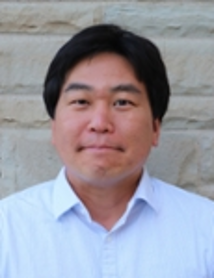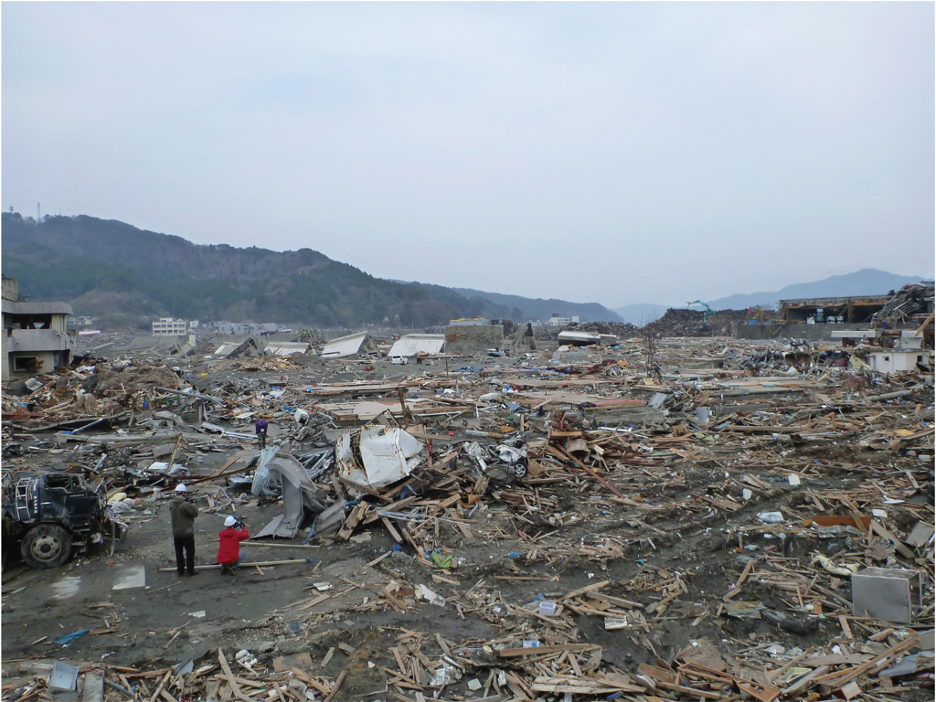Earthquakes and Tsunamis: Impacts and Implications on Society. How Can We Help Those Affected?
An interview with Dr. Katsu Goda, Associate Professor in the Department of Earth Science at the University of Western, Ontario and Canada Research Chair in Multi-Hazard Risk Assessment
Post tsunami in Minamisanriku City, Japan (Courtesy K Goda)
Interviewed by Rachel Pizzonia, BHSc Student, Faculty of Health Sciences
August 01, 2022
 Dr. Katsu Goda
Dr. Katsu Goda
On March 11, 2011 the Tohoku Earthquake and Tsunami took the lives of tens of thousands of people and forced millions out of their homes. At the time Dr. Goda, Ph.D. in Civil Engineering, was working at the University of Bristol. Once the news of the earthquake and tsunami broke out, Dr. Goda joined the UK Institute of Structural Engineers’ Earthquake Engineering Field Investigation Teams (EEFIT) and traveled to the affected areas of Japan's northeast regions. He brought in his expertise as an earthquake engineer, to study the impacts of this disaster, ultimately extending his research focus to tsunamis. Western Health Science student Rachel Pizzonia speaks with Dr. Katsu Goda, now based at Western University in Earth Sciences as the Canada Research Chair in Multi-Hazard Risk Assessment, to learn more about his work in multi-hazard risk assessment and earthquake engineering.
Rachel: For someone who has never heard of Multi-Hazard Risk Assessment, what does that involve? And, what motivated you to want to be involved in these assessments? Why?
Dr. Goda: I will share about myself. I did my Ph.D. at Western University, in Civil Engineering with a specialization in Earthquake Engineering. After graduation, I took an academic position as Lecturer and Associate Professor at the University of Bristol. When I was working in the UK, the 2011 Tohoku Earthquake and Tsunami happened. I was considered to be unique in the UK because I had an earthquake engineering background and I was Japanese. When this disaster happened, about 20,000 people lost their lives and it led to about $1 trillion loss. It was a huge event, and I was able to visit those affected areas of Japan, called Tohoku region (Northeast Japan) three times, and brought my expertise as an earthquake engineer. I looked at the buildings and how they collapsed. I was really fascinated by how the shaking shook the buildings from the ground and the impact the tsunami had.
The multi hazard risk assessment is a tool/framework/methodology to quantify how much risk we might have in a typical building and in urban and rural environments. It is also utilized to quantify the risk in terms of casualty, fatality, and regional economic impact, and to determine how long, more broadly, the community might be affected.
Rachel: Was it difficult to see the aftermath of the earthquake?
Dr. Goda: Yes. You can find many images of the earthquake online - it was a complete destruction. When I went back there, about three months later, half of the things had already been demolished and the clean-up had started. However, there was still a very strong smell when you were there. There used to be a whole community, but it just simply wiped out and you could not see anything or anybody. As a Japanese, I could feel the emotions in people's faces. I share their culture and even without speaking, I was able to sense how difficult it was for them. I grew up in Japan, and I know the difficulties of tsunamis. We experience a lot of natural disasters in Japan, but this event was just simply too much. Usually within a week or so, we overcome these kinds of events and we restart. But this was really significant and the recovery and restoration are still ongoing, even 11 years after the event. There are people today who are still relocated and cannot get back to their home locations. This earthquake even caused the Fukushima nuclear disaster. People have gone through a lot and it is still an ongoing problem.
Rachel: How do natural disasters affect the quality of life of the citizens in highly affected areas? What are some of the challenges the survivors of natural disasters face?
Dr. Goda: The immediate thing of course, after the 2011 Tohoku event, was survival. We lost people, families, friends and so on, and that means that we lost community. We became disintegrated and people felt despair. They did not see hope. We always have life plans: “I'm going to go to a university and study a subject that I am passionate about, I will graduate and get a job, and I will have a family.” In a blink of an eye, all of those plans and dreams would go away. So for survivors, it was really insecure and uncertain how life might turn out in the future. That was a real loss, although those are individual effects and it really depends on the person.
Another issue that victims, engineers, and politicians have to deal with was that the infrastructure was damaged significantly. So we are talking about lifelines: electricity, gas, water, sanitation, disease prevention, health care delivery, etc., on which our lives depend. All those can be gone or impaired drastically. It would take so much time to get back to whatever normal existed. That is one of the typical things that those victims had to go through as a long process that could last years.
Rachel: Can you share an example for a high risk location where a Multi-Hazard Risk Assessment made a difference?
Dr. Goda: In conducting research at higher education institutions like Western, we tend to focus on a very focused subject, right? Of course, those are useful and important, but when you actually go to the disaster hit region, what you see is the combined effect. It is not just a shaking, or just the tsunami, but how much damage is caused as a whole. In a multi-hazard catastrophic event like the Tohoku disaster, within several seconds, shaking starts, and then the building might be damaged. Then immediately after that, aftershocks tend to happen. Usually smaller but more frequent events take place, and buildings will be continuously shaken. If your building is right on the coast, then the tsunami might hit in 30 minutes. For several locations during the Tohoku event, ten-meter tsunamis occurred. Ten meters! You can imagine that the ceiling of a second story or reaching even a third story, and at one extreme location, the highest level of water reached 40 meters above the mean sea level. Imagine that a whole building would be overtopped by the water. It results in significant damage. So, if we focus on a community, the community would have to go through seismic waves and then the tsunami, potentially landslides, and then the whole ground might sink by one meter due to tectonic movement. So the combined effect would be very significant. Compared to individual research subjects, there is not much research on the multi-hazard effect and there is a huge open field to study and assess this combined effect. We need to integrate seismic science, earthquake science, tsunami science, geotechnical science, engineering, and so on. So this whole research field is really exciting, and that is how I started this multi hazard risk assessment.
Rachel: Can Risk Assessments help to mitigate pre-existing social and health inequities when used in high risk disasters
Dr. Goda: I definitely think so. The Tohoku disaster left, of course, a disaster with the heaviest consequence or impact for the vulnerable people, like elderly, young kids, individuals with disabilities, both mentally, physically, and of course, the poor or financially disadvantaged. So those populations and their risks need to be taken into account.
There is only so much that one individual person or the homeowner can do. It really needs some sort of community-level protection. For instance, we need to have a higher embankment of the river to prevent flooding. It requires the attention and involvement of policy makers and city planners to manage the community’s risk properly. It is a wide-open research area for sure.
We have examples of this in Canada. In BC, the multi-hazard risk assessment activity for earthquakes is the highest within Canada. Because we have the Cascadia subduction zone, which is a 1000 km long subduction zone. Tofino, BC, is a really popular town for tourism, but it is right on the Pacific coast and is at high tsunami risk. A historical example of this risk is the Cascadia subduction earthquake that happened in 1700 AD, which was confirmed by geological data and Native American indigenous stories. The township of Tofino is very active and they are keen to assess the combined effects from seismic, tsunami and geo-hazards. They have secured the funding from the Canadian government to do such a quantitative risk assessment. I am taking part of this study from a tsunami perspective and am working with other seismologists, coastal engineers, practical engineers, and city planners. We bring all the expertise into one to develop a coherent plan to reduce the risk from the multi-hazard perspective.
Rachel: What should Canada be doing to help parts of the world that are at higher risk of earthquakes?
Dr. Goda: We all work together and we do this because the Canadian government signed up with the international Sendai framework, which was organized by The United Nations Office for Disaster Risk Reduction (UNDRR). The government ratified this agreement and now actual planning and actions need to be done at the provincial level and township level. In promoting the disaster risk reduction efforts, the Canadian government provides various funding to academics and practitioners, for instance, through the International Development Research Council (IDRC). This is a mechanism that the Canadian government is implementing and that has been successful. So I think Canada is doing well.
Rachel: What should Canada be doing to help mediate parts or the world that are at higher risk of earthquakes?
Dr. Goda: Of course, there are many ways to do the research, right? Not just disaster research, but also we face climate change. The problem we face is getting broader and broader and we really cannot solve it with just single disciplines. International collaboration is essential! The things we do in Canada might affect the US, but it might also affect other sides of the Pacific and then vice versa. What they do in China might affect Canadians also. We have seen the interconnected global effect through the pandemic and the gas price increase during the ongoing Ukraine crisis. This would be one example of the kind of global challenges that we face. We already have many talented people. We have a skill set and technology, but now what we really need is to consolidate those different talents and skills into a more coherent plan and actually solve these grand challenges. That is the exciting aspect of what Canadians can do and contribute. Again, this is not just for earthquakes and tsunamis, but also for climate change and other things as well. These are very exciting things and I am looking forward to seeing them progress.
Rachel: Dr. Goda, thank you very much for your time and for all the hard work you do!

